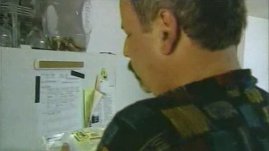Teachers' Domain - Digital Media for the Classroom and Professional Development
User: Preview

Source: TV411: Episode 108


Funding for the VITAL/Ready to Teach collection was secured through the United States Department of Education under the Ready to Teach Program.
In this video segment from TV411, a patient discusses how he keeps his diabetes under control. He explains how he keeps track of his carbohydrate intake by carefully reading food labels and keeping a daily journal used to calculate how many carbohydrates he consumes during each meal.
Here are some Frame, Focus and Follow-up suggestions for using this video in a math lesson.
What is Frame, Focus and Follow-up?
Frame: Spending money is easy. Keeping track of it takes a little more work. If you were given $50 and you had a list of things to buy for a birthday party, how would you keep track of what you spent to ensure that you didn’t go over your $50 budget?
Focus: In this video segment, you’ll see that in order for Steve to manage his diabetes, he needs to eat about 140 grams of carbohydrates every day. How does he keep track of his carbohydrate intake? What kinds of math operations does he use?
Follow Up: When Steve tracks his carbohydrate intake, how does he keep the information organized? After Steve eats breakfast, does he know how many carbohydrates he can still consume during the day? How could he figure this out?
STEVE: For me it was a silent, you know, what you would call a silent killer. I was feeling real good-real, real good. I said, "eh, if your feeling good, now's the time to go to your doctor for a check-up". And he said to me "by the way, you have a problem. And it's not a slight problem." He said, "You're diabetic." And that's sort of like the beginning of my journey, the beginning of my odyssey. But I knew that somebody out there had to help me deal with the diet. Before I went to the nutritionist, I wrote down a list of questions that I wanted answered, because I wanted to make sure that in the process I didn't leave anything out.
STEVE: In general, I'm a little bit confused, what general diet plan should I follow?
STEVE: And I must say, she was pretty good about answering them, and then helping me along.
NUTRITIONIST: Well, so I have some excellent information on reading food labels.
STEVE: Well, the first thing that she told me was that I had to start reading food labels, so that I'd be able to count carbs. There are foods that I'd been eating for years-I'd had absolutely no concept of whether they had many carbohydrates or few carbohydrates. But now, that's a very important part of my life.
STEVE: A food journal is very important in that, for me to feel well, I needed to consume approximately a hundred and forty grams of carbohydrates a day. The only way you could make sure that you were doing the right thing was to write down the exact amount of carbohydrates you had at every meal.
STEVE: So for breakfast, I had an English muffin, which is about twenty five grams of carbohydrates-it says it right there in the package-with some eggbeaters. For snacks, I had some triscuits, just to keep me going-about fifteen grams of carbohydrates. For lunch, I had a salad with six ounces of chicken and two slices of bread.
STEVE: So one slice of bread, or one serving, would be seventeen grams of carbohydrates, and two slices of bread would be two times seventeen or thirty-four grams of carbohydrates. And that's what I'm going to write down.
STEVE: The way that you were able to write down the correct amounts was to look on the boxes.
STEVE: On this day, I had twenty-five carbohydrates--English muffin for breakfast. I had thirty-five at lunch with roast pork with vegetables and rice. And I had a snack of thirty-four carbohydrates with pretzels. So in looking for something that would, in this magazine, something light for dinner-I find this recipe, fish baked and foiled, that was really light in carbohydrates. I also followed a recipe here for festive sweet potatoes, which gave me another twenty-three grams of carbohydrates. I still had some room left at the end, so I found this great recipe for "Fresh Fruit Fancy" which had sixteen grams of carbohydrates, and I met my daily requirement.
 Loading Standards
Loading Standards